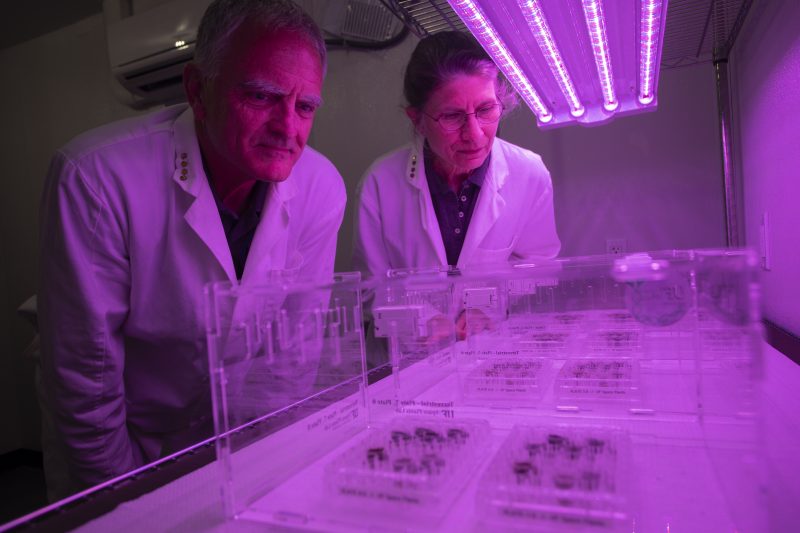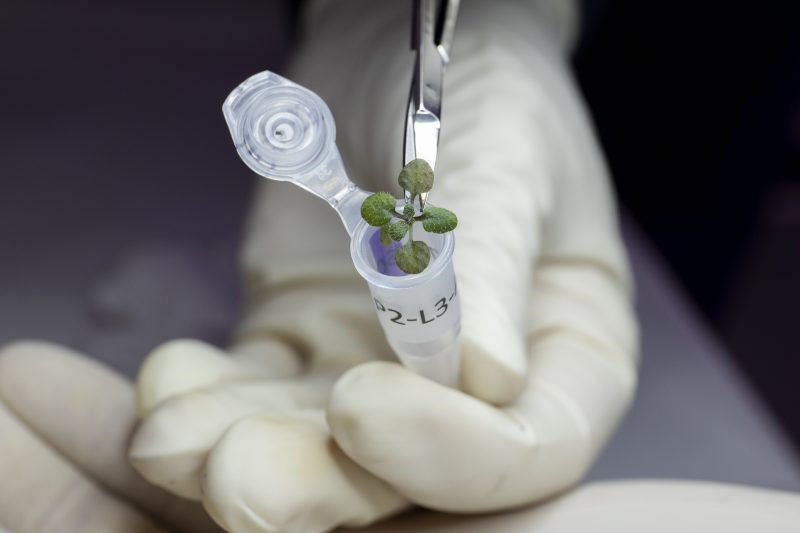
Originally published as Scientists Grow Plants in Lunar Soil on May 12, 2022, by NASA. The author is Bill Keeter.
Scientists grow plants in lunar soil
In the early days of the space age, Apollo astronauts had a visionary plan to bring back samples of the lunar surface material, known as regolith, so they could study it with state-of-the-art equipment and use it in future research. Now, 50 years later, as we are beginning the Artemis era and returning astronauts to the moon, three of those lunar samples have successfully grown plants. Researchers grew the hardy and well-studied Arabidopsis thaliana in the nutrient-poor lunar regolith.
NASA Administrator Bill Nelson said:
This research is critical to NASA’s long-term human exploration goals as we’ll need to use resources found on the moon and Mars to develop food sources for future astronauts living and operating in deep space. This fundamental plant growth research is also a key example of how NASA is working to unlock agricultural innovations that could help us understand how plants might overcome stressful conditions in food-scarce areas here on Earth.
Scientists at the University of Florida succeed
Scientists at the University of Florida make a breakthrough discovery that can both enable space exploration and benefit humanity.

Robert Ferl is a professor in the Horticultural Sciences department at the University of Florida and was a communicating author on a paper published on May 12, 2022, in the peer-reviewed journal Communications Biology. Ferl said:
Here we are, 50 years later, completing experiments that were started back in the Apollo labs. We first asked the question of whether plants can grow in regolith. And second, how might that one day help humans have an extended stay on the moon.
The answer to the first question is a resounding yes. Plants can grow in lunar regolith. They are not as robust as plants grown in Earth soil. Or even as those in the control group grown in a lunar simulant made from volcanic ash. But they did indeed grow. And by studying how the plants respond in the lunar samples, the team hopes to answer the second question as well, paving the way for future astronauts to grow nutrient-rich plants on the moon and thrive in deep space.
To boldly go, we must boldly grow
Jacob Bleacher is the Chief Exploration Scientist supporting NASA’s Artemis program at NASA Headquarters in Washington. Bleacher points out NASA is sending robotic missions to the moon’s South Pole to search for water that future astronauts can use. Bleacher said:
To explore further and to learn about the solar system we live in, we need to take advantage of what’s on the moon, so we don’t have to take all of it with us. What’s more, growing plants is the kind of thing we’ll study when we go. So, these studies on the ground lay the path to expand that research by the next humans on the moon.
Arabidopsis thaliana, native to Eurasia and Africa, is a relative of mustard greens and other cruciferous vegetables like broccoli, cauliflower and Brussels sprouts. It also plays a key role for scientists. Due to its small size and ease of growth, it is one of the most studied plants in the world, used as a model organism for research into all areas of plant biology. As such, scientists already know what its genes look like, how it behaves in different circumstances, even how it grows in space.

Working with teaspoon-sized samples
To grow the Arabidopsis, the team used samples collected on the Apollo 11, 12 and 17 missions. Each plant used only a gram of regolith. Then, the team added water and seeds to the samples. Next, they put the trays into terrarium boxes in a clean room. Lastly, they added a nutrient solution daily.

Anna-Lisa Paul, a professor in Horticultural Sciences at the University of Florida and first author on the paper, said:
After two days, they started to sprout! Everything sprouted. I can’t tell you how astonished we were! Every plant – whether in a lunar sample or in a control – looked the same up until about day six.
After day six, it was clear that the plants in lunar soil were not as robust as the control group plants growing in volcanic ash. And the plants were growing differently depending on which type of sample they were in. The lunar soil plants grew more slowly and had stunted roots. Additionally, some had stunted leaves and sported reddish pigmentation.

Plants grown in lunar soil ground up to study
After 20 days, just before the plants started to flower, the team harvested the plants. They ground them up and studied the RNA. In a biological system, scientists decode genes in multiple steps. First, they transcribe the genes, or DNA, into RNA. Then, they translate the RNA into a protein sequence. These proteins carry out many of the biological processes in a living organism. Sequencing the RNA revealed the patterns of genes that were expressed. This showed that the plants were indeed under stress and reacted the way Arabidopsis responds to growth in other harsh environments.
Additionally, the plants reacted differently depending on which sample – from different areas on the moon – was used. Plants grown in the Apollo 11 samples were not as robust as the other two sets. Nonetheless, the plants did grow.
Sowing the Seeds for Future Research
This research opens the door not only to someday growing plants in habitats on the moon, but to a wide range of additional questions. Can understanding which genes plants need to adjust to growing in regolith help us understand how to reduce the stressful nature of lunar soil? Are materials from different areas of the moon more conducive to growing plants than others? Could studying lunar regolith help us understand more about the Mars regolith and potentially growing plants in that material as well? All of these are questions that the team hopes to study next, in support of future astronauts traveling to the moon.
Sharmila Bhattacharya, a program scientist with NASA’s Biological and Physical Sciences Division, said:
Not only is it pleasing for us to have plants around us, especially as we venture to new destinations in space, but they could provide supplemental nutrition to our diets and enable future human exploration. Plants are what enable us to be explorers.
Bottom line: Scientists have succeeded in growing plants using lunar soil. This is essential for future space missions where humans may explore living on the moon or another planet.
The post Scientists grow plants in lunar soil first appeared on EarthSky.
